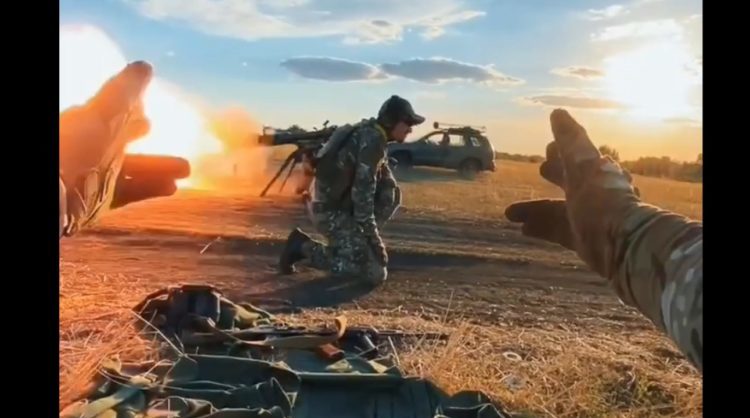Russian illegal invasion of Ukraine began in 2014, but in 2022 it entered a new phase of escalation. On 24 February 2022, at 5 o’clock in the morning, the Russian Federation launched a full-scale invasion of Ukraine, the Commander-in-Chief of Ukraine’s Armed Forces General Valerii Zaluzhnyi informed early in the morning one year ago.
Russian President Vladimir Putin announced a “special military operation” against Ukraine in a televised address before the break of dawn on Thursday, 24 February 2022. Within minutes after Putin’s war declaration, people all over Ukraine were woken up by loud explosions.
A powerful wave of missile strikes rolled from east to west and from north to south of the country. The invasion of the Russian forces from multiple directions by land, sea, and air followed. Russia unleashed the most devastating war in Europe since 1945 when the Second World War ended with a crushing defeat of Nazi Germany that brought lasting peace to the European continent.
Russian blitzkrieg and battle of Kyiv
On day one of the full-scale invasion, Russian forces crossed the Ukrainian border from the east, north, and south splitting their war effort into several axes of a rapid advance. In the south, Russia attacked the Kherson and Zaporizhzhia oblasts of Ukraine from the occupied Crimean Peninsula. In the east, Russian forces launched a large-scale offensive from the territory of the Russian Federation and the occupied Donbas region attacking Kharkiv, Donetsk, and Luhansk oblasts. In the north, Russia started an assault on Sumy, Chernihiv, and Kyiv oblasts using the territory of its ally Belarus to attack the Ukrainian capital Kyiv.
Russia had built up its forces of 190 000 troops on the Ukrainian border since March 2021, planning to pull off an overwhelming blitzkrieg aimed at capturing Kyiv and other big Ukrainian cities quickly.
Russian logistics, which heavily relied on railways, was prepared for a short war with minimum resistance from the Ukrainian people. Russian political and military leadership completely misjudged Ukraine, providing Russian troops that attacked the Ukrainian capital with parade uniforms to march down Kyiv after a successful and fulminant offensive.
These miscalculations of the Russian leadership defined the course of the offensive that aimed to surround and capture Kyiv within a matter of days. Although the US intelligence officials were concerned that Kyiv might fall under Russian control within days, Ukrainians braced up for heavy resistance. Ukraine’s Defense Minister Oleksii Reznikov recalls that western intelligence thought Ukraine would collapse rapidly and Kyiv would fall down within 72 hours.
“I saw personally a secret order from Russian commanders to their air assault troops that they have to control the government quarter in Kyiv within 12 hours,” Reznikov said in December 2022. He added that the order had been retrieved from a dead body of a Russian soldier on the outskirts of Kyiv.
In his interview with Radio Liberty on 23 February 2023, Joseph Borrell, the High Representative of the European Union for Foreign Affairs and Security Policy, said that no one expected that Ukraine would resist Russia so desperately.
“No one expected that Ukraine would resist like this. No one. And Putin certainly did not expect it. Putin was sure that in a matter of weeks, he would be in Kyiv. And of course, most of Ukraine’s friends were afraid that Ukraine would not stand,” Borrell said. “But the Russian army has demonstrated that its military is not as skilled as it was supposed to be, instead, Ukrainians are much braver and ready to defend their state.”
The key aim of the Russian offensive during the first phase of the full-scale invasion was highly likely to capture the Ukrainian capital, decapitate Ukraine’s leadership, and install a puppet government in Ukraine. The battle of Kyiv had to determine the further course of the war and the fate of the 40-million country.
Despite all odds and lack of confidence of the Ukrainian allies in the ability of Ukraine’s Armed Forces to prevent Russia from capturing Kyiv, Ukrainians did the impossible to defend their capital. The battle of Kyiv lasted from 24 February 2022 to 2 April 2022 when Russian forces retreated.
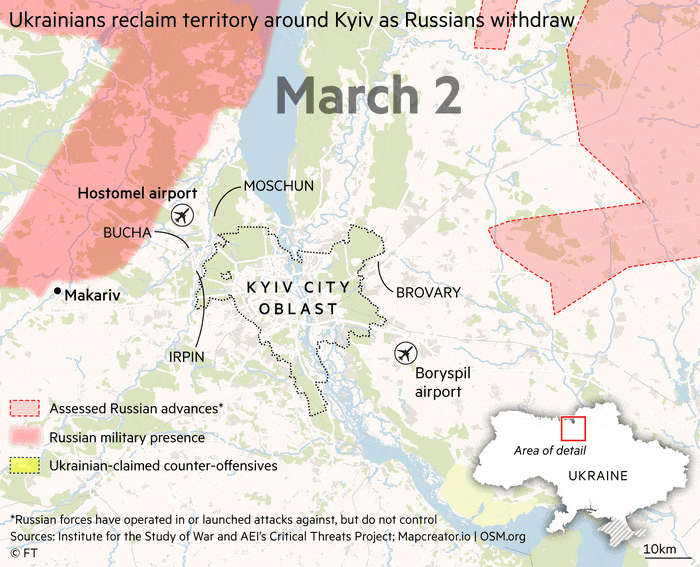
On 24 February 2022, Russia launched a massive missile attack on Ukraine targeting air defense systems, airfields, military bases, and critical infrastructure to paralyze Ukrainian defensive capabilities. The second step of the Russian military command came shortly with the rapid advance of the land forces inside Ukraine combined with amphibious operations. The aim of the amphibious assaults was to capture key objects and government buildings in the biggest cities, such as Kyiv, the second-largest city of Ukraine Kharkiv, and the Black Sea port Odesa. Russian forces planned to use helicopters, large Il-76 planes, and a naval landing force to reach their objectives.
Evolution of Russian tactics in Ukraine: From failed blitzkrieg to assault infantry
The operation aimed at capturing the Ukrainian capital involved several hundred paratroopers deployed to Hostomel (the airfield some 30 kilometers northwest of Kyiv) on 24 Mi-8 transport helicopters accompanied by ten large helicopter gunships Mi-24, Ka-52 combat helicopters, and 12 fighter jets.
Russians planned to turn Hostomel into a military base and huge logistics hub to receive large Il-76 transport aircraft that would deploy the main forces of the amphibious operation aimed at occupying Kyiv. In case Hostomel fell under Russia’s control, Russian forces could airlift more troops and heavy weaponry within a matter of hours. Such a scenario would have given Russian army an opportunity to amass forces close to Kyiv and break into the Ukrainian capital.
Russian Airborne Forces made an air assault on Hostomel international cargo airport early in the morning of 24 February, just a few hours after Putin’s televised war declaration.
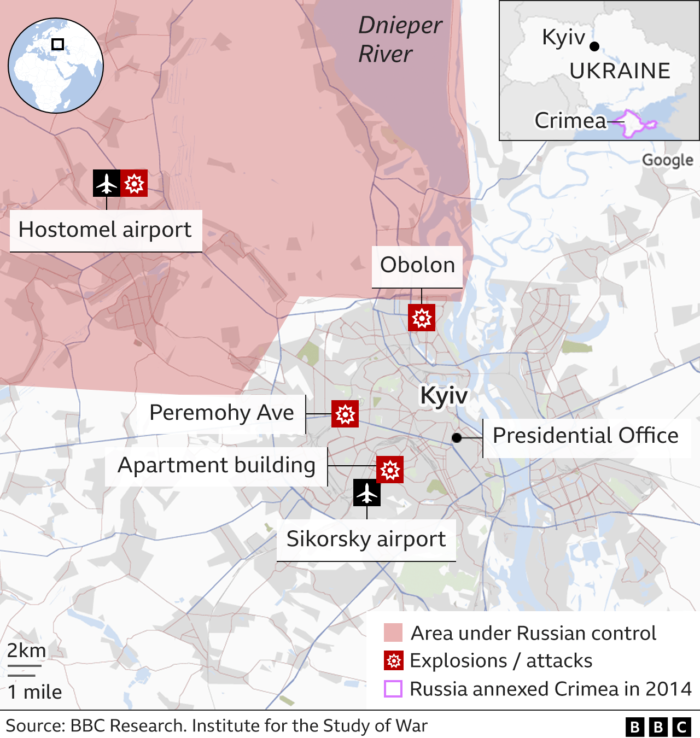
After hours of intense fighting, the regular Ukrainian Army combined with the National Guard and Territorial Defense units (the military reserve component of Ukraine’s Armed Forces created just a month before the invasion) pulled off a successful counter-attack, encircled Russian paratroopers that landed at the airfield, and repelled the assault on 24 February.
Russian attack on Hostomel resumed on 25 February. Another air assault by Russian Airborne Forces was supported by armored reinforcements coming from the territory of Belarus. After Russian land forces crossed the Ukrainian-Belarusian border early in the morning on 24 February, they captured the Chornobyl nuclear power plant and the exclusion zone around it, some 130 kilometers from Kyiv.
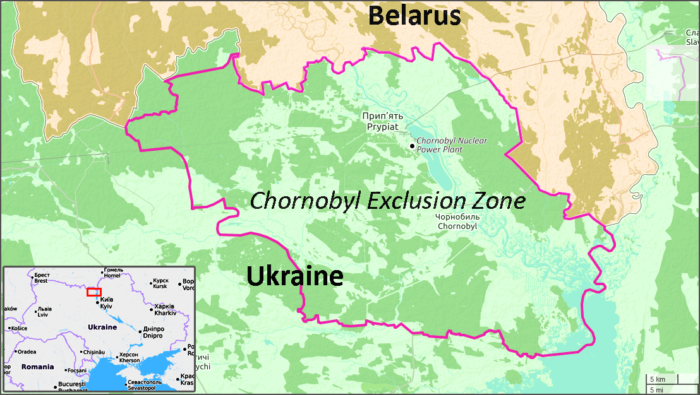
Breaking through the Ukrainian defenses in the Chornobyl area allowed Russian forces to support the amphibious operation against Hostomel on 25 February. Although the Russian army managed to capture the airport in Hostomel and occupy the entire city, the airfield was damaged during the battle and could not be used as a functional airstrip. Sadly, the Ukrainian cargo airplane An-225 Mriya, the world’s largest aircraft, was destroyed in its hangar during the battle of Hostomel.
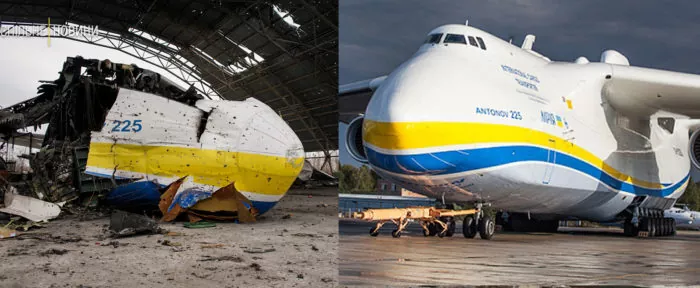
On 26 February, early in the morning, Russian paratroopers landed in the city of Vasylkiv (some 40 kilometers south of Kyiv) in order to capture Vasylkiv air base. On 26 February, Ukraine’s officials reported that the Ukrainian Su-27 fighter jet shot down the Russian strategic airlifter Il-76 that was carrying Russian paratroopers. Another Russian Il-76 was allegedly shot down by Ukrainian defenders near the city of Bila Tserkva in Kyiv Oblast on the same day. The attack of the Russian Airborne Forces on Vasylkiv was repelled.
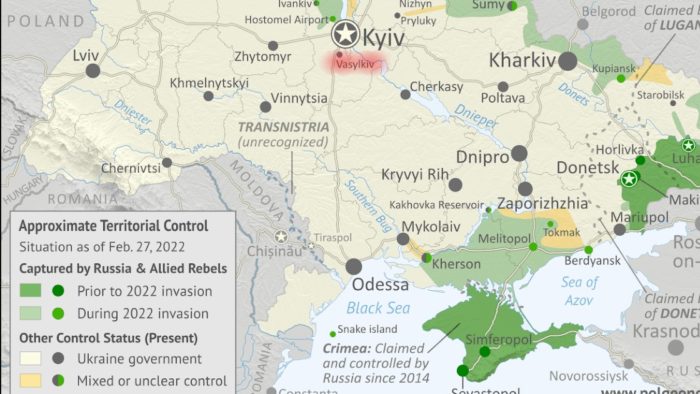
Map by Political Geography Now.
Despite the occupation of Hostomel and further advance towards Kyiv from the northwest, stiff resistance from Ukrainian forces managed to halt the Russian offensive and won some time that allowed the Ukrainian Army to redeploy reinforcements and strengthen the defense of Ukraine’s capital.
Considering that the main Ukrainian forces were deployed to the Donbas region in eastern Ukraine, the greatest burden of defense around Kyiv fell on the shoulders of the Ukrainian 72nd Mechanized Brigade stationed in Bila Tserkva (the largest city of Kyiv Oblast, 85 kilometers southwest of Kyiv).
General Colonel of the Ukrainian Armed Forces Oleksandr Syrskyy, who was in charge of the defense of Kyiv, had analyzed the possibility of the Russian attack on the Ukrainian capital and determined that Russian forces would advance towards Kyiv using three major highways. Two of those roads led from Belarus into the Chernihiv Oblast and down to Kyiv from the eastern bank of the Dnipro River.
Kyiv, the city of three million people, is split in half by the Dnipro River with the government quarter located on the hills of the western bank of the river. Considering that the Russian objective was to decapitate Ukrainian leadership, the fastest way to the government quarter was from northwestern suburbs of Kyiv, such as Hostomel, Bucha and Irpin.
To protect Kyiv, General Syrskyy organized two layers of defense: one in the suburban area of the Ukrainian capital and another in the city of Kyiv itself. The Russian plan assumed the Ukrainian capital would be defended by disoriented forces, while Ukraine’s political leadership, including President Volodymyr Zelenskyy would flee the city.
However, the Ukrainian President and government decided to stay in Kyiv despite the danger and refused to relocate to western Ukraine, which boosted the morale of Ukrainian defenders. Thousands of people in Kyiv and all over Ukraine joined the Territorial Defense units and the Armed Forces of Ukraine to defend their home.
Although Russian forces achieved some success in northwestern outskirts of Kyiv and managed to occupy Hostomel on the second day of the invasion and Bucha (some 30 kilometers from Kyiv) on 27 February, the Russian advance towards the Ukrainian capital from Chernihiv and Sumy oblasts on the eastern bank of the Dnipro River was stalled by the Ukrainian forces.
Unable to occupy big Ukrainian cities of Chernihiv (144 kilometers northeast of Kyiv) and Sumy (330 kilometers east of Kyiv), Russian forces had to leave these pockets of resistance in their rear trying to advance towards Kyiv as fast as possible. Such an approach made Russian supply lines vulnerable to attacks of Ukrainian partisans and Special Operations Forces in Chernihiv, Sumy and Kyiv oblasts. Ukrainians ambushed Russian military columns on the way to Kyiv and inflicted heavy losses on Russian forces that aimed to encircle Kyiv.
As the Russian blitzkrieg around Kyiv got bogged down in stiff resistance of the Ukrainian people, a joke about Russian military capabilities started to circulate amid Ukrainians: “Russia has the world’s second most powerful military army, the first being the Territorial Defense unit of Sumy city.” Such jokes demonstrated how high the morale of Ukrainians was in the face of relentless Russian invasion.
Clashes between Ukrainian defenders and Russian saboteur groups continued inside Kyiv during the first week of invasion. The Mayor of Kyiv Vitalii Klitschko imposed curfew in the Ukrainian capital in order to make it easier for Ukrainian forces to track down Russian saboteurs. Ukraine’s President Volodymyr Zelenskyy urged residents of Kyiv to prepare for the Russian assault and used everything they had at hand, from rifles to Molotov cocktails. Ukrainian authorities provided citizens with around 18 000 firearms during the first day of the Russian invasion alone.
One week after Russia’s invasion of Ukraine began, Kyiv was standing strong despite the danger of being encircled by the Russian army. Russian forces started to face the lack of ammunition, fuel and food supplies, while their lines of communications were constantly under attack. All key railway junctions and big Ukrainian cities in northern Ukraine, such as Chernihiv and Sumy, remained under control of Ukrainian forces, which paralyzed Russian overstretched supply lines.
While Ukrainian forces in Sumy and Chernihiv crippled Russian advance towards Kyiv with stinging attacks, unarmed locals used social media to report the movement of Russian forces along the highways and through their towns and cities, giving valuable information to Ukraine’s Armed Forces. Ukrainian IT volunteers created chatbots to help people report Russian movements in a fast and effective way.
Small Ukrainian military units maneuvered around the Russian ground lines of communications (GLOCs) hitting Russian forces with anti-tank weapons, such as Javelin and NLAW. While Ukrainian artillery used shoot-and-scoot tactic to pound at Russian forces, Ukrainian drone operators skillfully employed the Turkish-made armed drones Bayraktar TB-2 to burn down Russian tanks, infantry fighting vehicles, and artillery systems from the air.
The weather in late February and early March of 2022 was quite warm, which was beneficial for Ukrainian defenders. The snow started to melt. The muddy soil made it difficult for the Russian armored vehicles to move anywhere but on the roads.
On 10 March 2022, the Ukrainian battalion of the 72nd Brigade ambushed Russian tank convoy moving from Zalissya (38 kilometers from Kyiv) towards Brovary, the northeastern suburb of Kyiv (25 kilometers from the Ukrainian capital). On 19 March, Russian forces made another attempt to capture Brovary, but their assault was repelled.
https://twitter.com/TheStudyofWar/status/1629103095606128640
Ukrainian defenders managed to stall the Russian advance on the Ukrainian capital from both the northwestern and western suburbs of Kyiv. Due to the lack of reinforcements and weak control over the supply routes, Russian forces started to retreat from the vicinities of Kyiv in late March. On 2 April, the Ukrainian Ministry of Defense announced that Russian troops withdrew from the entire Kyiv Oblast.
Thus, in the beginning of April, Ukrainian forces retook the North. Russian forces retreated from Kyiv, Chernihiv and Sumy oblasts. Ukraine won the battle of Kyiv and entered the new chapter of the war: the battle of Donbas. Russian blitzkrieg failed. The war of attrition began.
Battle of Donbas
Russia redeployed its forces from northern Ukraine to the occupied areas of the Donbas region in eastern Ukraine. On 18 April 2022, Ukraine’s President Zelenskyy announced that the battle of Donbas began as fighting in this area intensified dramatically with Russian forces trying to advance in several directions.
By that time, Kherson (southern Ukraine) remained the only regional center and the biggest Ukrainian city that the Russian forces managed to occupy on 2 March 2022.
Russian offensive on the northeastern front towards Ukraine’s second-largest city Kharkiv was stalled by Ukrainian defenders.
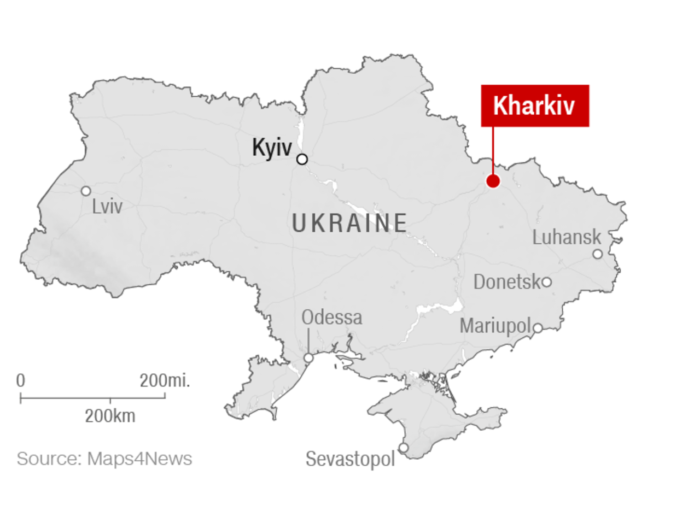
Map by CNN.
Unable to capture Kharkiv, which is located only 45 kilometers from the Russian-Ukrainian border, Russian forces started shelling the residential areas of the city daily killing innocent civilians. On 21 March 2022, the Russian shelling of Saltivka (the biggest residential district of Kharkiv) killed 96-year-old Borys Romanchenko, who survived Holocaust in 1940s and was engaged in preserving the memory of the crimes of Nazism in Ukraine.
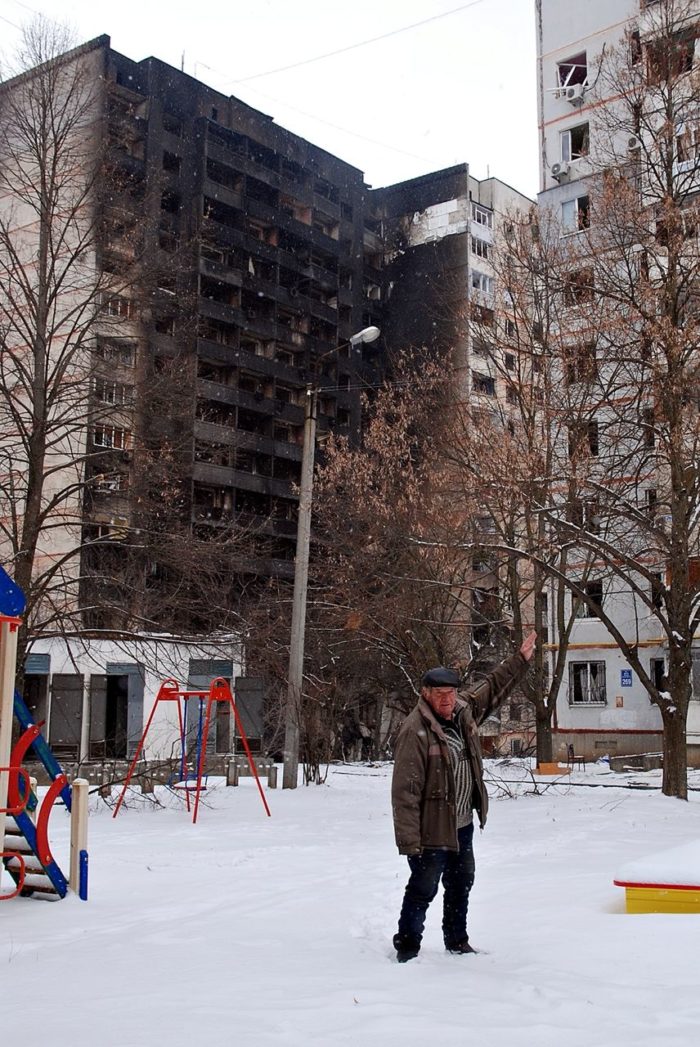
Targeting civilians in Ukraine became a widespread practice of the Russian forces from the first days of Russia’s full-scale invasion: from Bucha massacre in Kyiv Oblast to torture chambers on other occupied territories of Ukraine. The entire cities and villages in the Donbas region were razed to the ground by Russian artillery and air strikes.
Such cities as Rubizhne (Luhansk Oblast, eastern Ukraine), Sievierodonetsk (Luhansk Oblast), Mariyanka (Donetsk Oblast, eastern Ukraine), Avdiivka (Donetsk Oblast), Volnovakha (Donetsk Oblast), Popasna (Donetsk Oblast) and Mariupol (Donetsk Oblast, southeastern Ukraine) were obliterated by the Russian forces during the battle of Donbas.
https://twitter.com/EuromaidanPress/status/1621646966777155585
During the 82-day siege of Mariupol, Russia turned the city into a post-apocalyptic ghost town with entire neighborhoods smashed to the ground by Russian bombs.
One of the Russian air strikes targeted the Mariupol drama theater, where Ukrainian families with children were hiding from the incessant Russian bombardment. Hundreds of innocent people died in that building.
I was inside when the Russians bombed Mariupol drama theater: survivor’s story
After almost three months of fierce resistance, Mariupol fell under Russian control on 20 May 2022, which allowed Russia to secure a land bridge to occupied Crimea from the Rostov region of the Russian Federation through the occupied parts of Donetsk Oblast, Zaporizhzhia Oblast and Kherson Oblast.
The focus of the Russian forces shifted towards Sievierodonetsk and Lysychansk, the last major cities in Luhansk Oblast that remained under Ukrainian control. In May 2022, these Ukrainian stongholds continued stiff resistance, despite being nearly encircled by the Russian forces.
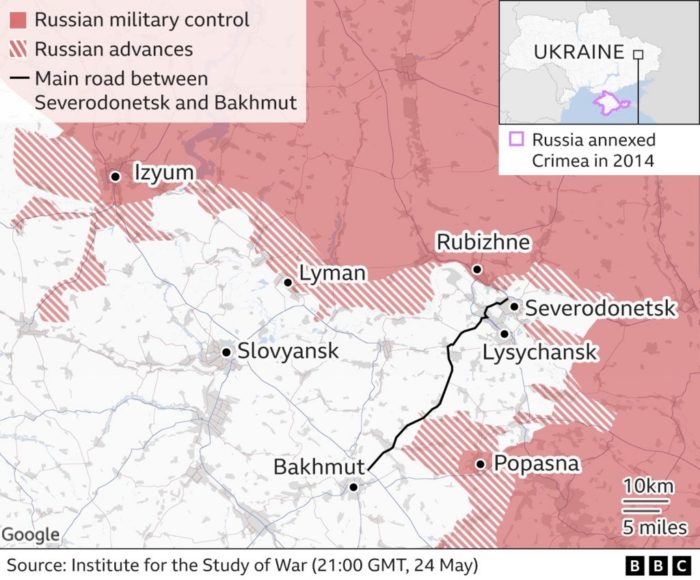
The battle of Sievierodonetsk was a meat grinder for the Russian forces that suffered heavy losses in intense urban combat. The fighting for Sievierodonetsk became one of the bloodiest battles of the Russo-Ukrainian war.
The battle of Donbas was marked with the change of tactics by the Russian forces. Instead of blocking the cities with large tank convoys, Russia switched to classic Soviet warfare relying heavily on massive artillery fire. Severodonestk and then Lysychansk, like many other towns in the Donbas region, were wiped out by the firewall of Russian artillery. While Ukrainian stockpiles of Soviet-era artillery ammunition started to shrink, Russia was able to fire ten shells against each Ukrainian shell.
After a firewall of Russian artillery shelling, the battalion tactical groups of the Russian forces (BTG) carried out a concentrated attack, trying to break through the defense line and create a bridgehead in order to advance further. Such tactic had a strong resemblance to that of the World War II. However, in the conditions where the enemy could monitor the battlefield and all manoeuveres from drones and satellites, any large armored convoy could become an easy target for artillery.
The last attack, where Russia employed the tactic of artillery firewall in the combination with the rapid tank breakthroughs, was carried out by the Russian forces near Bilohorivka (Luhansk Oblast, eastern Ukraine) in May 2022. When fording the river, the Russians lost up to 100 units of armored vehicles. After that, Russia did not attempt to carry out such attacks again. Until December 2022 and the first months of 2023, when Russian tank convoys failed to capture Vuhledar in Donetsk Oblast, eastern Ukraine.
By 14 June 2022, Russian forces captured most of Sievierodonetsk having cut off the key escape routes for Ukrainian defenders. On 24 June, all Ukrainian forces withdrew from the city allowing Russian army to occupy the ruins of Sievierodonetsk and advance towards the neighbouring city of Lysychansk.
The battle of Sievierodonetsk raged for one month, two weeks and five days. Russian forces managed to occupy Lysychansk in one week, on 3 July 2022. Lysychansk was the last major city in Luhansk Oblast that remained under Ukrainian control. When it seemed that Russian artillery firewall would keep forcing Ukrainian troops to roll back and retreat from the entire Donbas region, the new factor changed the tide of the war. The name of this factor is High Mobility Artillery Rocket System.
On 1 June 2022, the US announced that it planned to provide Ukraine with four HIMARS with the firing range of 80 kilometers. On 23 June, Ukraine’s Defense Minister Oleksii Reznikov confirmed that the first HIMARS arrived in Ukraine. Since that time, Ukrainian forces started to employ HIMARS to destroy Russian command posts and hit ammunitions dumps, oil depots, military bases and other targets in the Russian rear to degrade the capability of the Russian forces to carry out large-scale offensive operations.
Considering that Ukrainian allies began to provide Ukraine with artillery systems and 155-mm ammunition, the ability of Ukraine to deal with the Russian artillery fire increased significantly.
In April 2022, the United States provided Ukraine with 108 towed howitzers M777, Canada donated 4 howitzers M777, and Australia delivered to Ukraine 6 howitzers M777 with ammunition in order to help Ukrainian forces to repel Russia during the battle of Donbas. France started sending Ukraine self-propelled howitzers CAESAR, while Germany (along other countries) delivered German-made self-propelled howitzers PzH 2000.
Thus, battle of Donbas marked the shift of Ukrainian forces from Soviet-era artillery systems and 152-mm shells to NATO standards and 155-mm shells. Before that shift, such countries of eastern Europe as Bulgaria secretly provided Ukraine with Soviet-era ammo and fuel, as the lack of 152-mm shells started to become critical for the Ukrainian forces by the end of spring 2022.
Due to the military aid provided by Ukrainian allies and the valor of Ukrainian defenders, Ukraine managed to stall Russian offensive along most of the frontline that extended for 2400 kilometers. The new chapter of the war began by the end of summer 2022, as Ukraine prepared for a large-scale counteroffensive aiming to regain the lost territories.
Ukrainian counteroffensive
On 29 August 2022, Ukrainian Armed Forces launched a large-scale counteroffensive on the western bank of the Dnipro River in the Russian-controlled part of Kherson Oblast, southern Ukraine. Weeks of repetitive strikes with HIMARS on Russian transportation network, logistics hubs and ammunition dumps in the South preceded the counteroffensive operation. Ukrainian forces hit the Antonivskyy Bridge and other crossings across the Dnipro River in the city of Kherson and in Kherson Oblast numerous times preventing Russia from reinforcing its grouping on the western bank of the Dnipro River.
The Russian forces occupying the northwestern part of Kherson Oblast and the southern part of the neighboring Mykolayiv Oblast were getting gradually isolated from the Russian army stationed on the opposite eastern bank of the Dnipro River.
Ukrainian authorities started to signal an intended counteroffensive in Kherson Oblast more than a month before it actually started. Ukrainian officials publicly urged civilians to evacute ahead of the planned counterattack of the Ukrainian forces.
Reflecting on the Kherson counteroffensive few months later, the military historian Phillips O’Brien noted that he found it unusual for a side to openly signal an intended offensive. O’Brien claimed that Ukraine started waging a “new kind of war.” He suggested that by encouraging the Russian military command to redeploy forces from other occupied areas to the western bank of the Dnipro River and then attacking the bridges and cutting off all escape and supply routes, Ukraine was creating a trap.
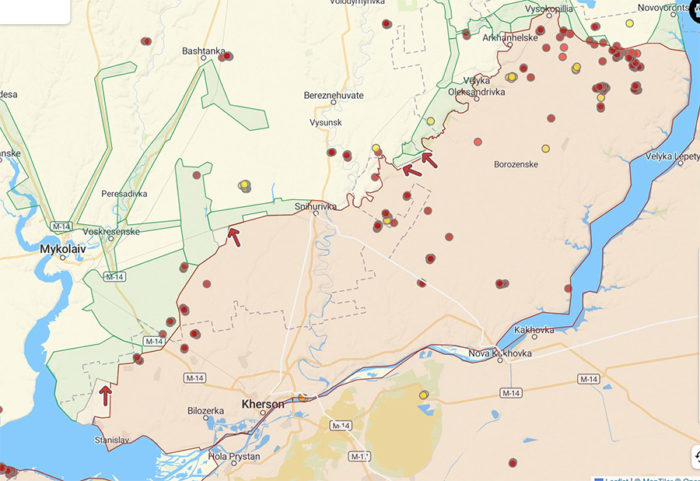
NASA FIRMS today’s 24h data on fires in Kherson Oblast. Map: DeepState
Ukrainian advance was slow due to the peculiarities of terrain in Kherson Oblast dominated by open fields with a landscape flat as tarmac. Ukrainian forces intensified the strikes on Russian concentration points, ammunition dumps, transportation network and other targets deep inside the Russian-controlled areas of Kherson Oblast.
After a week of heavy fighting and limited gains for the Ukrainian side in occupied Kherson Oblast, Russian military bloggers started to say that the Ukrainian counteroffensive failed. That was exactly the time when a rapid Ukrainian offensive started to unfold in another region of Ukraine, namely Kharkiv Oblast (eastern Ukraine).
Kharkiv counteroffensive started on 6 September 2022 alongside the slow advance of Ukrainian forces in Kherson Oblast, where Russia had previously deployed significant forces amid the rumors of the upcoming Ukraine’s counteroffensive in the South. Some of those forces were deployed to Kherson from Kharkiv Oblast.
Unlike the Kherson counteroffensive, where Ukrainian army was slowly grinding into Russian strongholds on the occupied territories, the Kharkiv counteroffensive looked like the unstoppable blitzkrieg. Ukrainian forces quickly recaptured the city of Balakliia, an important logistic hub, and advanced 75 kilometers inside Russian-controlled areas in just four days.
Ukrainians kept pushing. As a result, Russia lost control of Kupiansk, Izium, Sviatohirsk and Lyman. Three out of four of these cities were extremely important logistics hubs, the control over which gave Russia hope to continue its advance towards Sloviansk and Kramatorsk, the last major urban agglomeration of Donetsk Oblast (alongside the significantly smaller city of Bakhmut) that remain under Ukrainian control.
The Russian defense during the Kharkiv counteroffensive was broken so quickly most likely because the Russians lacked forces in Kharkiv Oblast, according to Mykola Bielieskov, a Research Fellow at the National Institute for Strategic Studies under the President of Ukraine.
“Russia had only one line of defense, Ukraine broke through it and then introduced its breakthrough development echelon that did not enter the cities but went in the direction of Volokhiv Yar, Shevchenkove, Kupiansk, and basically started to cut off communications,” Bielieskov noted.
Ukraine’s counteroffensive near Kharkiv: what enabled the Balakliia blitzkrieg
Kharkiv counteroffensive lasted for three weeks and five days and was stalled by the Russian forces on 2 October 2022 after Russia carried out “partial mobilization” of conscripts in September 2022 (some of whom were thrown at the frontlines immediately without any proper training).
During the Kharkiv counteroffensive, Ukraine managed to retake over 500 settlements and 12 000 square kilometers of Russian-occupied territory in the Kharkiv Oblast.
While Ukrainian forces were liberating large swathes of occupied territories, Russia orchestrated sham “referenda” in four occupied oblasts of Ukraine, namely in parts of Kherson, Zaporizhzhia, Donetsk and Luhansk oblasts. Swift annexation of these regions by Russia followed.
However, despite the fact that entire Kherson Oblast was annexed by Russia, Ukraine managed to retake the western bank of the oblast, including the city of Kherson, on 11 November 2022. Long weeks of successful Ukrainian strikes on the Russian rear degraded the Russian capacity to supply and reinforce its grouping on the western bank of the Dnipro River in Kherson Oblast, which made Russian military command withdraw its forces to the eastern bank of the river and retreat from Kherson.
Thus, Russia left the only major city and regional center that its forces captured during the full-scale invasion of Ukraine. The new phase of the war started.
Creeping advance of Russian forces in Donbas
After Russia lost large swathes of occupied territories during Ukrainian counteroffensive operations in Kherson and Kharkiv oblasts, Russian military command concentrated significant forces in the area of Bahmut in Donetsk Oblast, eastern Ukraine. Trying to regain momentum and distract Ukrainian forces from the preparation of a new counteroffensive, Russia changed tactics yet again.
Russian forces attempted to capture Bakhmut since August 2022 with little success. The assault on Bakhmut never stopped, even during Ukrainian counteroffensive operations in Kherson and Kharkiv oblasts. Having little strategic value, Bakhmut gradually gained huge symbolic meaning for both belligerent sides. While Russian forces strived to capture Bakhmut to demonstrate Russian society that they were still able to occupy new territories and win, Ukrainian forces held on to this small city in the Donbas to demonstrate that Ukraine would not hand Russia any more of Ukrainian territories.
After five months of unsuccessful frontal attacks on Bakhmut with assault infantry (which mainly consisted of convicts that the Russian mercenary group Wagner recruited in jails back in Russia), Russia shifted focus towards the small town of Soledar, some ten kilometers northeast of Bakhmut.
Russian forces strived to capture Soledar in order to envelop Bakhmut from the north and disrupt Ukrainian ground lines of communication (GLOCs), according to British Intelligence. In order to achieve that, Russia employed a new tactics that was strikingly different from what Ukrainian defenders had to deal with early in the war.
During the first stage of the war last spring, Russian armored vehicles, and tanks moved out front to lead the way until anti-tank weapons like Javelin, Stuhna, or NLAW started destroying all the lead vehicles and stalling convoys, according to Dan Rice, the Special Advisor to the Commander-in-Chief of Ukraine’s Armed Forces Valerii Zaluzhnyi.
On the other hand, the Russian offensive operations in and around Soledar and Bakhmut relied on incessant human waves of assault infantry that attack Ukrainian positions with the support of mortar and artillery fire, according to Andriy Zahorodniuk, former Ukraine’s Defense Minister (2019-2020).
Unlike previous stages of the war, the Russian infantry led the way in Soledar and Bakhmut a few kilometers in front of armored vehicles or without armor at all. Russian Wagner Group was thought to be spearheading the Soledar and Bakhmut offensives.
Poorly trained Russian convicts ususally participated in the first wave of Russian assaults on Ukrainian defense lines coming in small groups (around 15 soldiers), fully armed with assault rifles, machine guns, flamethrowers, and rocket-propelled grenades (RPG), according to Ukrainian war reporter Andriy Tsaplienko.
In case Ukrainian defenders managed to repel the first wave of attack, the second and third waves followed. These waves usually consisted of well-trained Wagner mercenaries and airborne infantry that continue the onslaught having accurate information about the Ukrainian positions spotted previously during the first wave of attack, according to Tsaplienko, who referred to an anonymous Ukrainian officer.
To counter such tactics, Ukrainians need more armored fighting vehicles with large-calibre machine guns and reconnaissance drones for effective counter-battery combat, according to Tsaplienko.
Finally, in order to stop creeping Russian offensive in the Donbas region and push Russian forces back,Ukraine needs modern battle tanks and more high-precision weapons, including American long-range ATACMS missiles (300-km range), which Ukraine’s President Volodymyr Zelenskyy asked for during his trip to the USA last December.
At this point,Ukraine is in critical need of ATACMS, drones, or manned aircraft to provide the long-range capability to hit targets deep inside the Russian-controlled areas, Lieutenant General Ben Hodges said in his interview with Euromaidan Press.
Hitting ammunition dumps, command posts, as well as logistic and transportation networks deep in the Russian rear may make it harder for Russians to prepare and launch offensive operations in Ukraine. Overall, Ukraine lacks the following weaponry and equipment in order to stall Russian offensive and be able to counterattack:
- cluster munitions, including DPICM
- counter-battery radars
- ATACMS surface-to-surface missiles
- infantry fighting vehicles
- modern battle tanks
- drones
- fighter jets
Fortunately, the tanks and infantry fighting vehicles are already coming, which gives Ukraine hope.
Although Ukrainian defenders were forced to leave Soledar, Bakhmut is still holding on. The Ukrainian army in Bakhmut inflicts heavy losses on the Russian forces. However, it would be naive and unrealistic to suggest that Ukrainian forces do not have any casualties while defending cities of the Donbas region from the creeping Russian offensive.
Russia is likely to keep mobilizing thousands and thousands of conscripts to degrade Ukrainian military and throw more infantry at them, the same way Russian forces did in Soledar and Bakhmut. Whether the next phase of the war is going to be marked with a successful Russian offensive or victorious Ukrainian counteroffensive depends on the timely military support for Ukraine by its allies, the resilience of Ukrainian society and valor of Ukrainian defenders.
One year of Russian all-out war against Ukraine on the map
Russian offensive vs. Ukrainian counteroffensive. pic.twitter.com/sOm8KzyTIU
— Euromaidan Press (@EuromaidanPress) February 24, 2023
A year ago, the Russian invasion of Ukraine started with the iconic words of the Ukrainian defenders on Zmiinyi (Snake) Island, a tiny stretch of land in the Black Sea attacked by a powerful Russian warship Moskva. When Russians offered a bunch of courageous Ukrainians to surrender, they heard a concise reply from the lonely island: “Russian warship, go f*** yourself.” This warship has already sunk. The Ukrainian flag is still flying high over the island.
Related:
- Kherson residents share joy of being freed from Russian occupation
- One year of Russia’s war against Ukraine: as it happened
- US announces $2 bn aid package for Ukraine, including drones, ammunition, electronic warfare
- Ukraine to liberate Crimea by end of August 2023 – Ben Hodges







